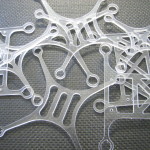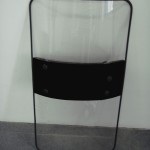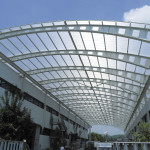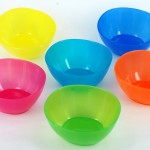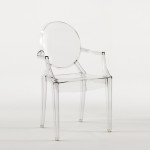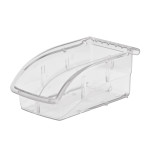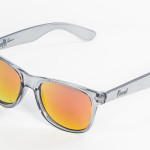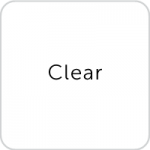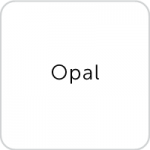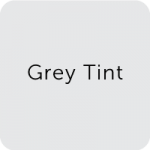Polycarbonate also known under its trade names as Lexan, Makrolon, Makroclear is a very durable plastic which is great for applications requiring high impact strength and repeated use. Polycarbinate is lightweight and strong enough to be used as shielding (level 3 bullet resistance) or to minimise the effects of vandalism and theft. Although polycarbonate is slightly less transparent than acrylic it is more dimensionally stable and of course stronger.
Applications
Polycarbonate has similar applications to acrylic but it has higher strength so it is typically used as a glass replacement. Polycarbonate is used as skylights and as a riot protection material to just name a few! The key advantage of polycarbonate over glass is the fact that it doesn’t shatter as it’s far less brittle – it has a lot more flex in it compared to acrylic. But polycarbonate is not limited to these applications it can be used for speciality clear furniture items or any application where high strength is required and a clear finish. Unlike glass, polycarbonate can be vacuum formed so it can make it great for mass production.
Colours shown above are just representations of a particular colour and aren’t necessarily the finished plastic colour. Lighting conditions, monitor calibration and variances in the plastic colour processing can impact the colour of a given material. For more information on colour availability please contact us.
|
Thickness
|
Ava.
|
Thickness
|
Ava.
|
Thickness
|
Ava.
|
|---|---|---|---|---|---|
|
0.5MM
|
4.5MM
|
 |
18MM
|
||
|
1MM
|
 |
6MM
|
 |
20MM
|
|
|
1.5MM
|
 |
8MM
|
 |
25MM
|
|
|
2MM
|
 |
10MM
|
 |
30MM
|
|
|
3MM
|
 |
12MM
|
 |
40MM
|
|
|
4MM
|
15MM
|
Please note that different materials have varying tolerances when it comes to thickness. A product should facilitate material variances +-0.2mm
|
Property
|
Value
|
Unit
|
|---|---|---|
|
Mechanical
|
||
|
Tensile Strength
|
65
|
MPa
|
|
Flexural Strength
|
93
|
MPa
|
|
Shear Strength
|
68
|
MPa
|
|
Impact Strength
|
6.5
|
J/m
|
|
Hardness
|
R118
|
M or R
|
|
Thermal
|
||
|
Working Temperature
|
138
|
°C
|
|
Vacuum Forming Temperature
|
191
|
°C
|
|
Thermal Expansion
|
3.75
|
10^-5/°C
|
|
Vicat Softening Temperature
|
149
|
°C
|
|
Miscellaneous
|
||
|
Specific Gravity
|
1.2
|
g/cm³
|
|
Water Absorption
|
0.15
|
% in 24 hr
|
|
Light Transmission
|
86
|
%
|
|
Dielectric Strength
|
380
|
Volts/Mil
|
|
Surface Energy
|
46
|
Dynes/cm
|
The information in the above data table is provided for educational purposes only in good faith and should only be used as a guide. As sheet material comes in a wide variety of grades, colours, textures and can contain different chemical properties, the figures only represent a typical insight into the specifications of the material. Information has been collated from a variety of sources. For more information on these figures and other properties please contact us.
| Resistant = |  |
Semi-resistant = |  |
Not Resistant = |  |
Blank = | Untested |
|
Chemical
|
Resistance
|
Chemical
|
Resistance
|
Chemical
|
Resistance
|
|---|---|---|---|---|---|
|
Acetamide
|
Freon and Frigen
|
 |
Propanol
|
||
|
Acetic Acid
|
 |
Fruit Juices
|
 |
Pyridine
|
 |
|
Acetone
|
Glycerine
|
 |
Salicylc Acid
|
||
|
Ammonia
|
Glykol
|
 |
Silicone Oils
|
 |
|
|
Anone
|
Glysantin
|
 |
Soap Solution
|
 |
|
|
Benzene
|
Heating Oil
|
 |
Soda Iye
|
 |
|
|
Benzine
|
Heptane and Hexane
|
 |
Soda Solution
|
||
|
Bitumen
|
Hydrochloric Acid
|
 |
Sodium Bisulphite
|
 |
|
|
Boric Acid
|
 |
Hydrogen Peroxide
|
Sodium Carbonate
|
 |
|
|
Butyl Acetate
|
 |
Hydrogen Sulphide
|
 |
Sodium Chloride
|
 |
|
Calcium Chloride
|
 |
Ink
|
 |
Sodium Nitrate
|
|
|
Carbon Tetrachloride
|
 |
Iodine
|
 |
Sodium Thiosulphate
|
|
|
Chlorbenzene
|
 |
Iso-octane
|
Styrene
|
 |
|
|
Chloroform
|
 |
Isopropanol
|
 |
Sulphur Dioxide
|
 |
|
Citric Acid
|
 |
Lactic Acid
|
 |
Sulphuric Acid
|
 |
|
Clophene
|
Linseed Oil
|
 |
Tar
|
||
|
Cupric Sulphate
|
 |
Methanol
|
 |
Tartaric Acid
|
 |
|
Cyclohexane
|
 |
Methyl Ethyl Ketone
|
 |
Tetrahydrofurane
|
 |
|
Cyclohexanone
|
 |
Methylene Chloride
|
 |
Tetralin
|
 |
|
Decalin
|
 |
Milk
|
 |
Toluene
|
 |
|
Diesel Oil
|
 |
Nitric Acid
|
 |
Transformer Oil
|
|
|
Dimethyl Formamide
|
 |
Nitrobenzene
|
 |
Trichlorethylene
|
 |
|
Diocthyl Phthalate
|
 |
Oxalic Acid
|
 |
Triethanolamine
|
 |
|
Dioxane
|
 |
Ozone
|
 |
Trilon B
|
|
|
Edible Fats & Oils
|
 |
Paraffin Oil
|
 |
Urea
|
 |
|
Ethanol
|
 |
Perchlorethylene
|
 |
Vaseline
|
 |
|
Ethyl Acetate
|
 |
Petroleum
|
 |
Water Cold
|
 |
|
Ethyl Ether
|
 |
Phenol
|
 |
Water Warm
|
 |
|
Ethylene Chloride
|
 |
Phosphoric Acid
|
 |
Wax
|
 |
|
Formaldehye
|
Potassium Dichromate
|
 |
Wine
|
 |
|
|
Formamide
|
Potassium Iye
|
 |
Xylene
|
 |
|
|
Formic Acid
|
 |
Potassium Permaganate
|
 |
The information in the above data table is provided for educational purposes only in good faith and should only be used as a guide. As sheet material comes in a wide variety of grades, colours, textures and can contain different chemical properties, the figures only represent a typical insight into the specifications of the material. Information has been collated from a variety of sources. For more information on these figures and other properties please contact us.


